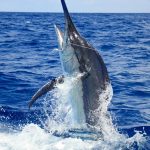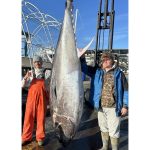NEWS
How Bad is the Lionfish Invasion? We’re Now Trying to Train Sharks to Eat Them
 Above: Photo Credit Antje Schultner
Back in 1985, a lone lionfish was first spotted off the Florida coast, possibly dumped into the ocean by a dissatisfied aquarium owner. At the time, it seemed harmless enough: a bright, colorful fish native to Indonesia that had somehow made its way over here.
No one could have imagined the disaster that would follow.
Thirty years later, the venomous lionfish has conquered the Atlantic, the Caribbean, and the Gulf of Mexico wreaking havoc on ecosystems up and down the coast. Unlike in its native Pacific habitats, there are few natural predators here to keep this invasive species in check. So the lionfish has expanded voraciously, gobbling up other reef fish and mollusks and attacking commercially important species like grouper and snapper.
PLEASE CLICK HERE for more information on how sharks are being trained to eat Lionfish on our website now…
VIDEO: Shark Feeding Frenzy on the Beach!
Above: Photo Credit Antje Schultner
Back in 1985, a lone lionfish was first spotted off the Florida coast, possibly dumped into the ocean by a dissatisfied aquarium owner. At the time, it seemed harmless enough: a bright, colorful fish native to Indonesia that had somehow made its way over here.
No one could have imagined the disaster that would follow.
Thirty years later, the venomous lionfish has conquered the Atlantic, the Caribbean, and the Gulf of Mexico wreaking havoc on ecosystems up and down the coast. Unlike in its native Pacific habitats, there are few natural predators here to keep this invasive species in check. So the lionfish has expanded voraciously, gobbling up other reef fish and mollusks and attacking commercially important species like grouper and snapper.
PLEASE CLICK HERE for more information on how sharks are being trained to eat Lionfish on our website now…
VIDEO: Shark Feeding Frenzy on the Beach!
 Above: On Thursday, October 8 at around noon, while at a retreat at Cape Lookout National Seashore off the Crystal Coast of North Carolina, the leaders of One Harbor Church witnessed a shark feeding frenzy. The men were out fishing for the evening’s dinner when they stumbled across more than 100 sharks attacking a school of blue fish. As seagulls and pelicans joined in on the meal, the men began to cast into the surf, catching fish without the use of bait. For more than five minutes, the sharks were observed swimming in and out of the surf, some of which became beached in the fury. Donnie Griggs, the cameraman who captured the footage, is an avid waterman who spearfishes, dives, swims and surfs at Cape Lookout often. We want it to be clear that Cape Lookout and the surrounding beaches of Eastern North Carolina are extremely safe for swimming. The presence of these sharks and large schools of fish is actually a sign of a very healthy ecosystem.
PLEASE CLICK HERE to view the video of the shark feeding frenzy on our website now…
Above: On Thursday, October 8 at around noon, while at a retreat at Cape Lookout National Seashore off the Crystal Coast of North Carolina, the leaders of One Harbor Church witnessed a shark feeding frenzy. The men were out fishing for the evening’s dinner when they stumbled across more than 100 sharks attacking a school of blue fish. As seagulls and pelicans joined in on the meal, the men began to cast into the surf, catching fish without the use of bait. For more than five minutes, the sharks were observed swimming in and out of the surf, some of which became beached in the fury. Donnie Griggs, the cameraman who captured the footage, is an avid waterman who spearfishes, dives, swims and surfs at Cape Lookout often. We want it to be clear that Cape Lookout and the surrounding beaches of Eastern North Carolina are extremely safe for swimming. The presence of these sharks and large schools of fish is actually a sign of a very healthy ecosystem.
PLEASE CLICK HERE to view the video of the shark feeding frenzy on our website now…
Angler Scott Nichols Releases Two Royal Slams in A Single Year
On September 12, 2014, angler Scott Nichols caught, tagged, and released a 200-pound swordfish to cap off his worldwide journey to become the first person to achieve two Billfish Royal Slams in a single year. Over the years, more than one hundred anglers have accomplished the most prestigious achievement in billfishing – the Billfish Royal Slam. Recognition by the International Game Fish Association (IGFA) for the Royal Slam requires the successful capture of nine different species of billfish in a lifetime, but many anglers have done it within a year. Nichols is the first to achieve two Royal Slams of the required species in a given year and the first to tag a Royal Slam with TBF tags within that time period.
Beginning the journey in Cap Cana, Dominican Republic on September 21, 2013 aboard the Get Lit, Scott tagged his first blue marlin and then released another blue the following day, starting his quest for two royal slams in a year. From there he headed to Miami Beach where he knocked off his first swordfish with Capt. Bouncer Smith and then headed to Cabo to catch two striped marlin. Fishing in his home waters off of Stuart, Florida in February of 2014, Scott released an Atlantic Sailfish and then headed to Los Suenos, where he released the needed Pacific sailfish for both slams. He then took a trip out to Kona, Hawaii and checked off two spearfish and a Pacific blue marlin with Capt. Chip Van Moles. Swinging back through Cap Cana, Scott caught a needed white marlin aboard the Sea Check and tagged another white on the Sandman with Capt. Scott Leon.
PLEASE CLICK HERE to read more on angler Scott Nichols and his TWO royal billfish slams in one year on our website…

Above: Completing the Second Royal Slam on Sept. 12, 2014 with Capt. Bouncer Smith. Photo courtesy of Scott Nichols.
Unmanned Aerial Vehicle Offers a New View of Killer Whales
For the first time, scientists have used an unmanned aerial vehicle to study killer whales from above. The device they’re using is a remote-controlled hexacopter with a high-resolution camera mounted in its belly, and the photos it produces are beautiful and full of detail. The images offer an entirely new view of this species.
But scientists aren’t taking pictures just because they look nice. The images contain detailed information that scientists can use to monitor the health of individual killer whales and of their population as a whole.
To get these photos, scientists from NOAA Fisheries teamed up with colleagues at the Vancouver Aquarium. The animals they studied are the Northern Resident killer whales of British Columbia, a population that’s listed as threatened under Canada’s Species At Risk Act, and the pilots were trained and operating under permits issued by the Canadian Government. Like the endangered Southern Residents that spend summers near Seattle, these whales eat salmon—mainly Chinook salmon—and some of the salmon runs they rely on are much smaller than they used to be. In fact, several Chinook runs are themselves endangered, and scientists are concerned that a lack of prey may be limiting the whale populations.
Please click HERE to view more on the viewing of killer whales with unmanned drones on our website…

Above: Two northern resident killer whales photographed by a remote-controlled hexacopter from 100 feet. The whale on the left is in very poor condition and is thought to have recently perished. The whale on the right is healthy and in the prime of his life. Scientists are using the hexacopter as a cost-effective and non-intrusive method for monitoring the health of killer whales. Photo credit: NOAA, Vancouver Aquarium.
Updated Catch Reports Section of ROFFS™ Website
Be sure to visit the section titled “Catch Reports” located under the “Insights” tab on our ROFFS™ website that will feature current catch reports from areas such as the Northeastern U.S., North Carolina/Hatteras, South Carolina/Georgia, Florida, the Florida Keys, the Bahamas, and the Gulf of Mexico. We continue to post weekly updates in this category so please check back often.
Please click HERE for MORE photos and to view last week’s catch reports…
 Above: Photo Credit Antje Schultner
Back in 1985, a lone lionfish was first spotted off the Florida coast, possibly dumped into the ocean by a dissatisfied aquarium owner. At the time, it seemed harmless enough: a bright, colorful fish native to Indonesia that had somehow made its way over here.
No one could have imagined the disaster that would follow.
Thirty years later, the venomous lionfish has conquered the Atlantic, the Caribbean, and the Gulf of Mexico wreaking havoc on ecosystems up and down the coast. Unlike in its native Pacific habitats, there are few natural predators here to keep this invasive species in check. So the lionfish has expanded voraciously, gobbling up other reef fish and mollusks and attacking commercially important species like grouper and snapper.
PLEASE CLICK HERE for more information on how sharks are being trained to eat Lionfish on our website now…
VIDEO: Shark Feeding Frenzy on the Beach!
Above: Photo Credit Antje Schultner
Back in 1985, a lone lionfish was first spotted off the Florida coast, possibly dumped into the ocean by a dissatisfied aquarium owner. At the time, it seemed harmless enough: a bright, colorful fish native to Indonesia that had somehow made its way over here.
No one could have imagined the disaster that would follow.
Thirty years later, the venomous lionfish has conquered the Atlantic, the Caribbean, and the Gulf of Mexico wreaking havoc on ecosystems up and down the coast. Unlike in its native Pacific habitats, there are few natural predators here to keep this invasive species in check. So the lionfish has expanded voraciously, gobbling up other reef fish and mollusks and attacking commercially important species like grouper and snapper.
PLEASE CLICK HERE for more information on how sharks are being trained to eat Lionfish on our website now…
VIDEO: Shark Feeding Frenzy on the Beach!
 Above: On Thursday, October 8 at around noon, while at a retreat at Cape Lookout National Seashore off the Crystal Coast of North Carolina, the leaders of One Harbor Church witnessed a shark feeding frenzy. The men were out fishing for the evening’s dinner when they stumbled across more than 100 sharks attacking a school of blue fish. As seagulls and pelicans joined in on the meal, the men began to cast into the surf, catching fish without the use of bait. For more than five minutes, the sharks were observed swimming in and out of the surf, some of which became beached in the fury. Donnie Griggs, the cameraman who captured the footage, is an avid waterman who spearfishes, dives, swims and surfs at Cape Lookout often. We want it to be clear that Cape Lookout and the surrounding beaches of Eastern North Carolina are extremely safe for swimming. The presence of these sharks and large schools of fish is actually a sign of a very healthy ecosystem.
PLEASE CLICK HERE to view the video of the shark feeding frenzy on our website now…
Above: On Thursday, October 8 at around noon, while at a retreat at Cape Lookout National Seashore off the Crystal Coast of North Carolina, the leaders of One Harbor Church witnessed a shark feeding frenzy. The men were out fishing for the evening’s dinner when they stumbled across more than 100 sharks attacking a school of blue fish. As seagulls and pelicans joined in on the meal, the men began to cast into the surf, catching fish without the use of bait. For more than five minutes, the sharks were observed swimming in and out of the surf, some of which became beached in the fury. Donnie Griggs, the cameraman who captured the footage, is an avid waterman who spearfishes, dives, swims and surfs at Cape Lookout often. We want it to be clear that Cape Lookout and the surrounding beaches of Eastern North Carolina are extremely safe for swimming. The presence of these sharks and large schools of fish is actually a sign of a very healthy ecosystem.
PLEASE CLICK HERE to view the video of the shark feeding frenzy on our website now…
 Above: Completing the Second Royal Slam on Sept. 12, 2014 with Capt. Bouncer Smith. Photo courtesy of Scott Nichols.
Unmanned Aerial Vehicle Offers a New View of Killer Whales
Above: Completing the Second Royal Slam on Sept. 12, 2014 with Capt. Bouncer Smith. Photo courtesy of Scott Nichols.
Unmanned Aerial Vehicle Offers a New View of Killer Whales

 Above: Two northern resident killer whales photographed by a remote-controlled hexacopter from 100 feet. The whale on the left is in very poor condition and is thought to have recently perished. The whale on the right is healthy and in the prime of his life. Scientists are using the hexacopter as a cost-effective and non-intrusive method for monitoring the health of killer whales. Photo credit: NOAA, Vancouver Aquarium.
Updated Catch Reports Section of ROFFS™ Website
Above: Two northern resident killer whales photographed by a remote-controlled hexacopter from 100 feet. The whale on the left is in very poor condition and is thought to have recently perished. The whale on the right is healthy and in the prime of his life. Scientists are using the hexacopter as a cost-effective and non-intrusive method for monitoring the health of killer whales. Photo credit: NOAA, Vancouver Aquarium.
Updated Catch Reports Section of ROFFS™ Website
 Above: Sailfish are working south too. Some now off Charleston, SC. ROFFS™ clients angler JD Menger (first offshore trip) with Capt. Ashley Heaton & mates Lisa Carter and Jake Heaton fishing aboard “Southern Grace”.
Above: Sailfish are working south too. Some now off Charleston, SC. ROFFS™ clients angler JD Menger (first offshore trip) with Capt. Ashley Heaton & mates Lisa Carter and Jake Heaton fishing aboard “Southern Grace”.




